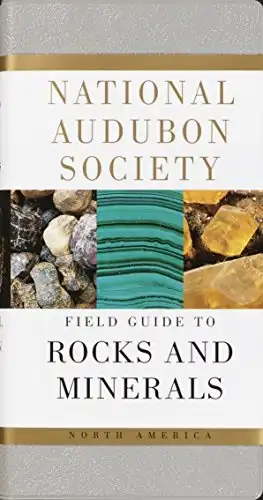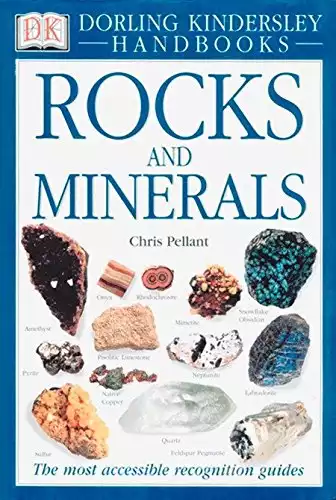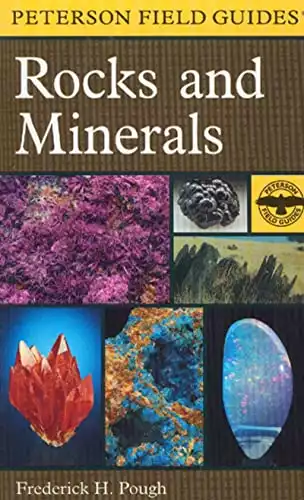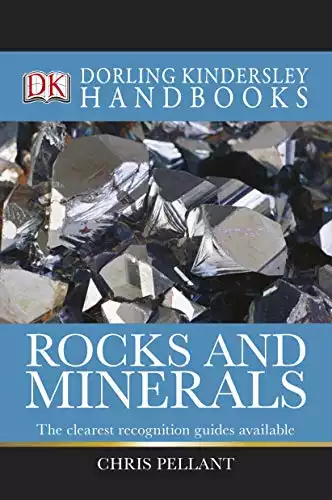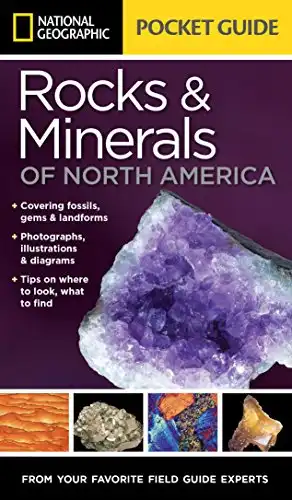When you’re a beginner at rockhounding, all rocks look the same. Is this light green rock a tourmaline? Or is it beryl? You never know! That’s why it’s always better to have a rock identification guide at your disposal.
The identification guide will help familiarize your eyes with the rocks and minerals you may find at your mining destination. It’ll also tell you the differences between the seemingly similar rocks you find.
When choosing a field guide, it’s important to consider factors like the size and weight of the guide, the quality of the photos and illustrations, and the level of detail provided about each specimen. Additionally, some guides may be geared towards beginners, while others may be more appropriate for experienced collectors.
Our top pick offers a comprehensive collection of specimens, detailed descriptions, and high-quality photographs to help you identify rocks and minerals with ease. Whether you’re a beginner or a seasoned collector, this guide is an excellent resource for exploring the world of rocks and minerals.
The Top Guidebooks for Rock and Mineral Identification
Whether you’re a geology enthusiast, a student, or a professional geologist, these guides will help you identify and learn about different rocks and minerals found in various locations around the world. Without further ado, here are our top picks for the best rock and mineral field guides.
National Audubon Society Field Guide to Rocks and Minerals
Perfect for every rock collector and geology enthusiast to have on hand. This valuable reference covers more rocks and minerals in North America than any other available guide.
If you’re looking for a comprehensive guide to rocks and minerals, the National Audubon Society Field Guide to Rocks and Minerals: North America is an excellent choice.
Pros
- The guide is packed with information and includes over 250 full-color pages.
- The high-quality photos are sorted by color, making it easy to find the rocks you’re looking for.
- The guide is part of the National Audubon Society Field Guides series, which are known for their accuracy and reliability.
Cons
- The print quality of this edition is not as good as older editions.
- Some users found the photos to be unclear or low-quality.
- The guide is quite heavy and may not be ideal for carrying around in the field.
The National Audubon Society guide
One of the things we liked most about this guide is the way the photos are organized. They’re sorted by color, so it’s easy to find the rocks you’re looking for. The photos are also high-quality and show the rocks in their natural state, which is helpful for identifying them in the field.
The guide is part of the National Audubon Society Field Guides series, which are known for their accuracy and reliability. We found the information in the guide to be thorough and well-researched, and we appreciated the detailed descriptions of each rock and mineral.
One downside to this guide is that the print quality of this edition is not as good as older editions. Some users have also found the photos to be unclear or low-quality. Additionally, the guide is quite heavy and may not be ideal for carrying around in the field.
Overall, we would definitely recommend the National Audubon Society Field Guide to Rocks and Minerals: North America to anyone looking for a comprehensive guide to rocks and minerals. It’s packed with information, easy to use, and accurate.
Smithsonian Handbooks: Rocks & Minerals
If you’re looking for a comprehensive guide to rocks and minerals, Smithsonian Handbooks: Rocks & Minerals is definitely worth considering.
Pros
- The
book is well-organized and easy to navigate, making it simple to find the information you need. - The photographs are stunning and provide a clear representation of each rock or mineral.
- The descriptions are detailed and informative, making it easy to identify different rocks and minerals.
Cons
- The
book is a bit heavy and not very portable, so it may not be the best option for those who need to carry it around. - Some readers have noted that the
book is a bit outdated, so it may not include all of the latest information on rocks and minerals. - The
book is geared more towards intermediate to advanced rock collectors, so it may not be the best option for beginners.
Overall, we would highly recommend Smithsonian Handbooks: Rocks & Minerals to anyone who is interested in rocks and minerals. The
In the first section of the
One thing that sets Smithsonian Handbooks: Rocks & Minerals apart from other field guides is its focus on the visual aspects of rocks and minerals. The photographs are truly stunning and provide a clear representation of each rock or mineral, making it easy to identify them in the field.
Overall, if you’re looking for a comprehensive guide to rocks and minerals, Smithsonian Handbooks: Rocks & Minerals is definitely worth considering. With its detailed descriptions, stunning photographs, and well-organized layout, it’s sure to be a valuable resource for anyone who wants to learn more about these fascinating geological formations.
A Field Guide to Rocks and Minerals
If you’re looking for a comprehensive guide to identifying rocks and minerals, A Field Guide to Rocks and Minerals is a great option.
Pros
- Provides detailed descriptions of rocks and minerals
- Organized by color for easy identification
- Compact size makes it easy to take with you on the go
Cons
- Limited number of pictures
- Some information may be outdated
- May be too technical for beginners
We found A Field Guide to Rocks and Minerals to be a helpful resource for identifying rocks and minerals. The guide provides detailed descriptions of each specimen, making it easier to identify them in the field. We also appreciated that the guide is organized by color, which makes it easier to find what you’re looking for.
One downside of the guide is that it has a limited number of pictures. While the descriptions are helpful, it can be difficult to identify a specimen without a picture to reference. Additionally, some of the information in the guide may be outdated, as it was first published in 1953.
Finally, we found that the guide may be too technical for beginners. While the descriptions are detailed, they can be difficult to understand if you don’t have a background in geology. However, if you’re willing to put in the effort to learn, A Field Guide to Rocks and Minerals is a great resource for rockhounds and mineral collectors alike.
Rocks and Minerals (Dorling Kindersley Handbooks)
If you want to learn about rock and mineral identification for the sake of it, rather than search in specific states, this guide will be a perfect choice for you. Rocks and Minerals handbook provides photos, descriptions, and info about various rocks and minerals you may encounter during rockhounding.
The
One more thing to love about this guide is its clear, large text that’s in line with the pictures. The
National Geographic Pocket Guide to Rocks and Minerals of North America
We saved one of the best for last! This pocket guide from National Geographic is the best companion you can have on your rockhounding trips. Its display of rocks and minerals is limited to North America, so you don’t drown in the sea of information.
National Geographic’s beginner guide includes photos and information about a large variety of rocks, along with gems, fossils, minerals, and land formations. The layout is logical and easy for you to skim through so that you can reach the rock you’re looking for faster.
Along with photographs of the rocks and minerals, the guidebook explains the places where you’ll likely find these rocks. Plus, it addresses North America’s land formations that help with rockhounding.
The guide has clear identification points that enable you to search faster. It’s sure to make your rockhounding adventure much easier.
How to Get Into the Rockhounding World
If you’re a beginner to the rockhounding world, a mere
Do Enough Research
When looking to get into rockhounding, it’s better to search close to your area first. The first thing to look for is the unique geological traits. By getting familiar with those samples first, you won’t be exposed to any foreignness regarding territories.
Besides, you’ll slowly get used to searching for specimens. That’s if your state’s formation allows for rockhounding. If not, look for the closest mining site.
Connect With Others
Rockhounding alone will only get you so far; it’s sometimes important to share your hobbies with others to learn the techniques better.
First, check if there’s a collector’s club in your area. This will guarantee you learn the right approaches to collecting, along with the right tools to use. Plus, you can start some chats on your rockhounding trip. Associating with people that have the same hobby always gives you some useful insights.
Get the Right Equipment
The key to starting any hobby right is getting the right tools, especially when it’s something as intricate as hunting for rocks and minerals.
Don’t get tricked by looks; you don’t need to get the most expensive tools out there to ensure their efficiency. As a beginner, you’ll only need the basic equipment, including safety glasses, shovels—short-handed preferred—, a rock hammer, chisel, bucket, mallet, gloves, and a pair of tough boots.
Bear in mind that some sites won’t need any tools; you can find the rocks and minerals right on the ground without digging. So, make sure you know what you’re going to need before buying something unnecessary.
Document Every Rock
Documentation is an essential part of any activity. With rockhounding, it’ll provide a reference for you to get back to when you need it. You can start by keeping a record of the specimens’ unique names and their mined year.
If you want to go an extra step, record the rock’s varietal and mineral name, along with some details about mining —depths and levels, for example. You’ll find the information pretty useful later on when you revisit certain sites.
Save the Identifying Labels
If, by any chance, you obtain specimens from others, make sure to keep their labels. Each rock’s history is what determines whether it’s rare. This is a required added value to your collection.
If you want to sell your rocks and minerals, this step will come in handy later on.
Make Sure Your Sources Are Reliable
There’s no better investment than a reference
No one can memorize all the rocks and minerals on his own; you’ll inevitably need some help, especially if you’re a beginner. A guide
Closing Thoughts
Rockhounding is easier than it implies. While you may think you’re going into a complicated world of mining, it’s actually pretty simple. As long as you have the right tools and your identification guide is in your pocket, you’ll be fine!
To choose the best rock and mineral identification guide, try to limit yourself to a few states. That guarantees you won’t have to look into hundreds of different photographs that’ll prove of no worth. Carrying a guide dedicated to your state or the ones around you is always the better choice.
- Online rock and mineral club for collectors of all levels!
- Find community with like-minded rock and mineral enthusiasts.
- Monthly Giveaways!
- Free Access to Entire Digital Library of Products (current and future products)*

